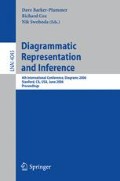Abstract
The process of member validation requires researchers to present their findings back to the communities that have been studied to gain their appraisal of the work. By depicting subject matter that ranges from the physical to the conceptual, diagrams provide a valuable alternative to the written documents traditionally used in member validation. This paper reports on a study in which diagram-based member validation was used to assess the accuracy and acceptability of the researchers’ interpretations. The manner in which the technique was implemented, the benefits that were realized and possible directions for future work are all discussed.
Access this chapter
Tax calculation will be finalised at checkout
Purchases are for personal use only
Preview
Unable to display preview. Download preview PDF.
References
Bloor, M.: On the Analysis of Observational Data: A Discussion of the Worth and Uses of Inductive Techniques and Respondent Validation. Sociology 12, 545–552 (1978)
Cheng, P.C.-H.: Diagrammatic Knowledge Acquisition: Elicitation, Analysis and Issues. In: Shadbolt, N.R., Schreiber, G., O’Hara, K. (eds.) EKAW 1996. LNCS, vol. 1076, pp. 179–194. Springer, Heidelberg (1996)
Crilly, N., Blackwell, A.F., Clarkson, P.J.: Graphic Elicitation: Using Research Diagrams as Interview Stimuli. Qualitative Research 6 (in press, 2006)
Emerson, R.M., Pollner, M.: On the Use of Members’ Responses to Researchers’ Accounts. Human Organization 47(3), 189–198 (1988)
Hegarty, M.: Mental Animation: Inferring Motion from Static Diagrams of Mechanical Systems. Journal of Experimental Psychology: Learning, Memory and Cognition 18(5), 1084–1102 (1992)
Kesby, M.: Participatory Diagramming as a Means to Improve Communication about Sex in Rural Zimbabwe: a Pilot Study. Social Science and Medicine 50, 1723–1741 (2000)
Author information
Authors and Affiliations
Editor information
Editors and Affiliations
Rights and permissions
Copyright information
© 2006 Springer-Verlag Berlin Heidelberg
About this paper
Cite this paper
Crilly, N., Clarkson, P.J., Blackwell, A.F. (2006). Using Research Diagrams for Member Validation in Qualitative Research. In: Barker-Plummer, D., Cox, R., Swoboda, N. (eds) Diagrammatic Representation and Inference. Diagrams 2006. Lecture Notes in Computer Science(), vol 4045. Springer, Berlin, Heidelberg. https://doi.org/10.1007/11783183_34
Download citation
DOI: https://doi.org/10.1007/11783183_34
Publisher Name: Springer, Berlin, Heidelberg
Print ISBN: 978-3-540-35623-3
Online ISBN: 978-3-540-35624-0
eBook Packages: Computer ScienceComputer Science (R0)

